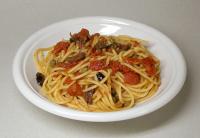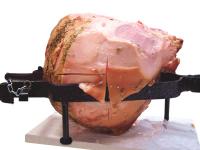-
Posts
688 -
Joined
-
Last visited
Content Type
Events
Forums
Downloads
Quizzes
Gallery
Blogs
Posts posted by Sarge
-
-
-
 true, he was hilarious when he stood as Timmy Mallett at Key 103 radio .... nowadays we have plonkers like Jonathan Ross & Russell Brand
true, he was hilarious when he stood as Timmy Mallett at Key 103 radio .... nowadays we have plonkers like Jonathan Ross & Russell Brand 
-
sceadugenga, LaoPo has been quicker on the mark in answering your question. I'd like to expand a bit on his reply. Any meat is more flavoursome when still on the bone, therefore you can't use an electric slicer with that prosciutto cotto shown here. Having said that, nowadays most of deli shops and restaurants, everywhere in the world, use hams already de-boned for easier and quicker cut. In the case of expensive hams like San Daniele & Pata Negra, they come on the bone and you have to use a stand. These meats will be cut in front of customers (in delis or at restaurant tables), by a trained person using a specialist long and slender knife. The beauty of these hand cut hams is that you get a slice of variable thickness and none slice is the same, unlike when using an electric slicer
-
... The Best Way To Go, over 50 thai gf one baby .....
silly me and I initially read it like somebody passed away romping with 50 Thai chicks and leaving a baby behind, but what a way to go

on a serious note, Lite Beer's advice is spot on
-
broadcasted on TV
-
Yes, both use tomato paste (listed as tomato semiconcentrate) - depending on the flavor anywhere from 5% up to 12% per my memory. We use tomato paste as well in similar qtys, perhaps 1-2 points higher, depending on the flavor.
At the moment, no, we don't make our own paste, as we don't have the equipment for large-pack. Something for future growth....
I trust you are aware if your Thai supplier/s produced the paste using hot break at 100 °C to retain full pectin, so not to "doctor it" using artificial thickeners or worst starch. Still your percentage is too high. Something to look into it
Yeah, its about 2 servings per 360ml jar.We have capability to make 480ml and 720ml jars, probably 1-ltr as well, but at the moment demand favors the smaller size as the market in general is still in an evaluation phase for our new brand. Perhaps in due time....
I find your current 360g size odd, any particular reason for the smaller than the international standard size of 400g? Also I found that the really large size (700g plus) only work in USA, we did try in Australia but without much success. Again something you should consider carefully.
I always have garlic bread with my pasta as well - such a nice compliment - and I love LOTS of garlic!!
typical Kanos (as in AmeriKanos, a term used in Phils for Americans but now widely used to describe any westerners, similar to farang in Thailand), trust them to screw up anything about food. Pasta is intended as an appetizers, a small portion starter before tucking in the main course (either fish or meat) and not as a standalone full main course. Plus one shouldn't really eat bread with pasta as it's a double intake of starch, resulting bloated belly and flatulence if eaten regularly in large portions (pasta & bruschetta).

-
Gallic population grows
-
Putnesca is quick by its nature. I melt the anchovies in olive oil, then add fresh tomatoes, canned romas from Italy, olives (I use Kalmatas), capers (lots of them), salt, and pepper. The only things I add any different are one dried red chile, marinated artichoke hearts, a splash of wine, and a spoon of condensed demi glace. I bring all the ingredients with me from the US, and the sauce is done far sooner than the pasta (I like penne) and costs about $2 for the meal with enough left over to freeze for another meal.You could possibly make a quick Putanesca sauce from our olive flavor... just add some anchovies and some chili if you like it spicy. We do have capers in the sauce, but if you like a lot, you might want to add more as well. Our olive flavor is available at Food Hall and Villa Market (Rimping if you're in CM).
expanding on this classic sauce, Puttanesca which is one of my favourite, I wonder if you guys actually know the etymology of the name and the colourful legend behind it
-
I'm currently trying to hire for two roles - a marketing communications manager and a business development manager - for a large international organisation. Both roles are covering a number of offices in South East Asia. Both can be based in Bangkok.
Both attract salaries of around 150-180,000 per month, but I'm buggered if I can find anyone half decent.
.... and after this post his inbox will be bursting from pms
-
what's your excuse
he's a Sydneysider a breed of their own
-
the issue is not if LBs (men in drags) are gays but rather if "normal" men having intercourse with other men (LBs) are gays or not. They are, both of them. So yes, this thread belongs to the gay section, where the OP will find better advice
-
Where do you think the Italians got their tomatoes, which is considered the ingredient that turned flatbread into pizza?
Imported from America!
which part of America would that be?
-
as an aside, how are the tourist figures doing at the mo? after a high profile campaign, of few years ago, that played on national stereotypes, creating bit of "interest" abroad (and I'm using an euphemism here), nothing has been heard since. I understand that the Indonesian took the baton and carried on with it: Aussies, where the Bali hel_l are you?

-
OK, Sarge, I found a couple bottles of both Agnesi and Barilla I had leftover... unfortunately neither is Amatriciana, but I wanted to share with you what even the Italian companies engage in.
There are various languages on both lables - english, spanish, french, one I"m not familiar with (either slavic or russian?), and another that the import label covers and I can't tell what it is.
Agnesi Olive: standard ingredients, except they include rice starch
 . Heresy?
. Heresy?now compare these two:
Agnesi Arrabbiata: normal looking ingredients, 2.4% olive oil (good), however, they include less than 1% anchovy paste and capers. Rice starch as well (
 ). Sounds kinda like a minimalist Putanesca.
). Sounds kinda like a minimalist Putanesca. Barilla Arrabbiata: more than 2% sunflower seed oil (
 OMG!!), sweet peppers, less than 0.5% EVOO. No anchovy or capers.
OMG!!), sweet peppers, less than 0.5% EVOO. No anchovy or capers.Edit: both show a tiny fraction of a percentage of "chili" 0.18% & 0.2% (presumably hot chili) - my guess is it is powdered chili, based on the tiny amount.
So who's got it right? Neither?
What should the proper ingredients be?
industrial made sauces (or any precooked food) have some stabilizing ingredients and processes to make them shelf stable. One has to consider that they’re shipped, sometimes for weeks, (think of Australia, 4 weeks journey plus a couple days stop over in Singapore in tropical heat, stored in sealed containers. A product that perhaps was produced in N. Italy during winter, where temperatures reach zero at times) to the four corners of the globe under totally different climate and environment. Then also you have to factor in how these products are handled and stocked by local importers before they reach the shelves of your supermarkets. Furthermore all manufacturers “play” with processes and recipe tweak sauces (as you do) to reach a middle ground in taste, where the product is not “offensive”, i.e. strong flavours or too bland. I’d like to hear your business model and supply chain.
Just a couple of comments on the ingredients (as I said earlier, professional advices, recipe development and ideas how to better run your business cost money), you failed to mention tomato paste, and the percentage of it in those sauces. Do you use paste in your sauces and in what percentage? If you do, is that something you make or buy off the shelves from somebody else? If you don’t, why not? Chilli, of course they use powder version in industrial processes, what do you expect? an army of chilli choppers working alongside production lines? lines that run millions of jars
Now, Kirk please offer some guidance and help to your customers (me included, as I will purchase your sauces); any manufacturer worth its salt should advice on how best to use their products thus giving the best possible experience. When I buy your sauces, lets say, Amatriciana, Ricotta & Parmesan. What should I do with them? I like Italian food but I don’t really know how to use these sauce, I have poor cooking skills. Also, where to store and how long for. Help us out. Here some points that you can offer guidance:
1. Are your sauces intended for pasta only?
2. Can you recommend me what shape of pasta for a particular sauce?
3. How do I use your sauces?
4. Do I need to boil, stew, simmer, grill, poach, pour them? What’s the recommended process?
5. Can I add extra ingredients to your sauces? Which one you recommend for which sauce?
6. How many people will your standard jar feed?
7. How much pasta do I need to cook?
8. How long should I cook the pasta for? Can you recommend the correct process?
9. Once opened do I have to use all the sauce?
10. If I don’t use it all immediately, where and how should I store/keep the remaining sauce?
11. How long for?
12. Any health and safety advice?
13. I have a problem with your product (my child got bouts of diarrhea after eating - it badly stained my shirt/trousers - I got halitosis and flatulence after eating your Ricotta & Parmesan cheese sauce - there is a suspect particle inside - smell badly - rotten & rusty lid - sauce separates & becomes runny when warmed up - strange, unusual taste - etc...), what do I do? Do you have a customer complaint phone number/mail address? Do I take it back to the store I purchased from?
14. Do you have a customer help line for suggestion, recipe ideas, news about forthcoming new products, nutritional information etc..?
-
you can get them at iStudio gonna pick up one in January
-
under the bed
-
-
Although someone may be good at doing something, it doesn't necessarily mean they are a good at doing business.
that begs the question, if you don't know how to run or start up your own business (idea) how on earth can you advice others'?
In fact, thousands of businesses hire business analysts to examine and improve their businesses.true but they already have an existing business, you go none and waiting for somebody to tell you how kick start yours.
This is Faulty Tower stuff, que?

-
.... and if he does, will you grab him by his schlong before he drowns?
-
becoming funnier as his hands ...
-
preserving in jars
-
sorry gone too
-
-
I lived in Australia for 12 years (no sympathy needed i'm over it) and they did a survey on meat pies and found most of the fillings were kangaroo and believe it or not camel when i heard that i was hopping mad and got the hump. But yes i agree totally crap.
cor blimey 12 yrs? I lived there for 3 yrs, I feel for you. Anyway what's this about aussie pies? One can go to any British pub and get that muck, prolly better made. As for Sydney pies, lot of that stuff is manufactured in Perth and shipped frozen there to Woolies & Coles supermarkets, IGA and other food stores. I can't think of any typical aussie muck apart from lamington. Talking of which, I know a supplier down in the Central Coast. If there is a demand I can get imported (via a Thai distributor) in Thailand.









The Three Word Story!
in Word Games
Posted
sporting a comb-over